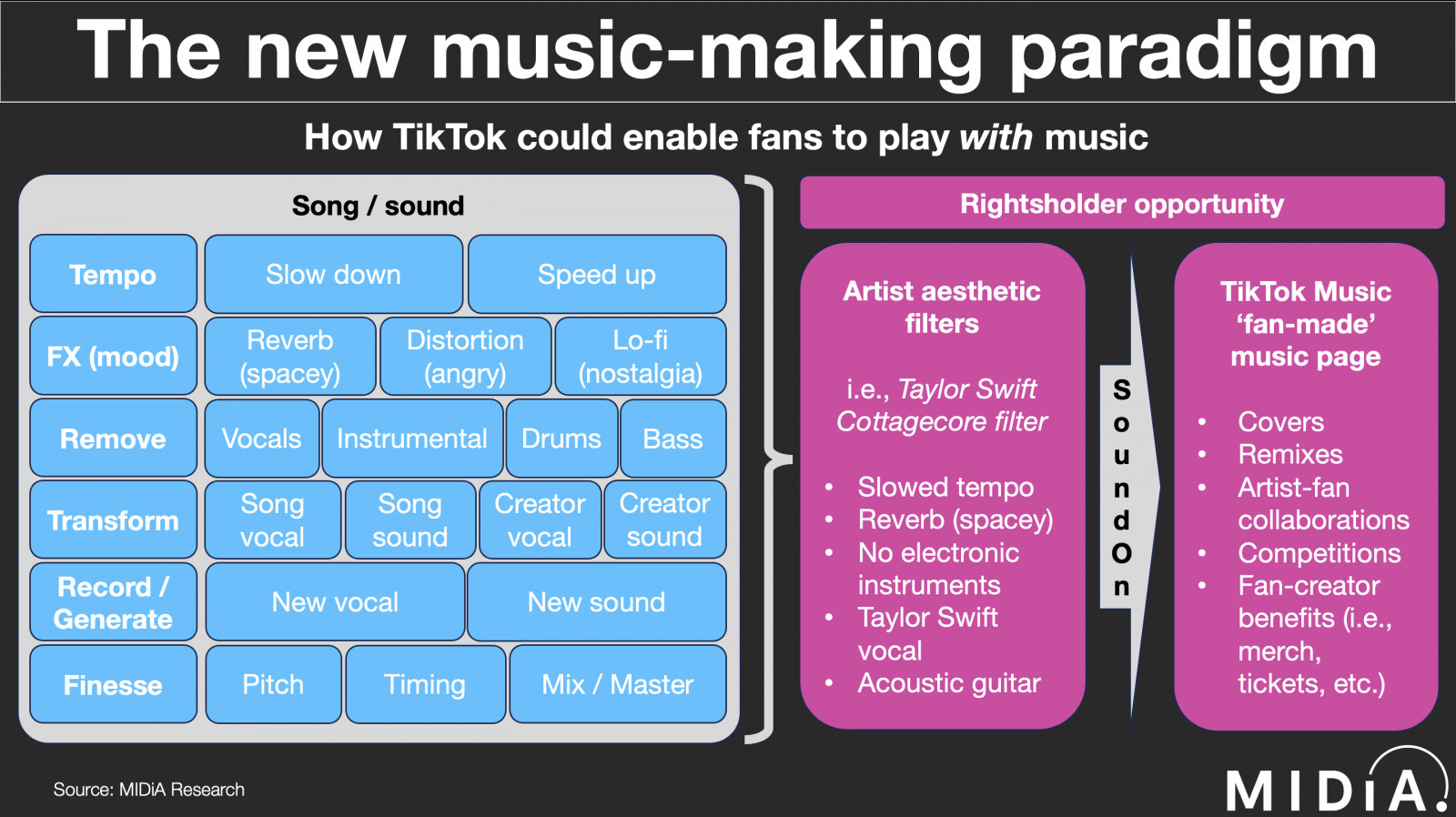A new era of ‘fan-made’ music is about to begin


Since MIDiA’s comments on TikTok’s music production ambitions more than two years ago, a lot has changed. Consumers have become bolder and more engaged in playing an active role in their music consumption. From syncing songs to videos to changing tempos, consumption has become synonymous with creation.
BandLab has also conditioned millions of users to embrace mobile music-making and cloud-based production, breaking artists in the process. With this have come new tools and expectations of tools. For instance, AI songwriting and effects that function in a similar format to Instagram filters.
And now TikTok has now stated outright that they are “working on a creative tool that provides music creation and audio editing capabilities” to “lower the music creation barrier and inspire musical creativity and expression”. We have seen ByteDance experiment with music creation in Mawf and Ripple. The experiment is over: TikTok’s music-making era is about to begin.
TikTok is about to put music production into the hands of over a billion users. Fans will not only use music in response to trends, but soon make music to create them. The problem is that these creators are going off the platform to make music to participate in the culture TikTok has created.
In the same way that users flowing to Spotify to listen to viral tracks led to the creation of TikTok Music, TikTok will bring in the production tools that creators engage with to express themselves with music. As TikTok builds out its creation capabilities, here is what to expect.
Creation becomes an entertainment vertical
Say you want to use a sped up version of a song you like. It won’t be long before that process is embedded into platforms and fans can speed up or slow down however they like. As you are making a video you will be able to mould your added music to the content as you please - all with a swipe. Then we have other filters and effects like reverb, distortion, lofi, etc. that can be used to express feeling spacy, angry, nostalgic etc. Again, all with a swipe.
However, sped up and slowed down songs with FX will only go so far in entertaining creators. This is where AI comes into the picture. First, it will be stem splitting (i.e., removing the drums, slowing it down, and adding some reverb). Or, removing everything except the vocal(s), speeding it up, and adding some overdrive. With stem splitting, music can be built and deconstructed like Legos.
Featured Report
Defining entertainment superfans Characteristics, categories, and commercial impact
Superfans represent a highly valuable yet consistently underleveraged audience segment for the entertainment industry. What drives this disconnect is the fact that – despite frequent anecdotal use of the term – a standardised, empirical definition remains absent, preventing companies from systematically identifying, nurturing, and monetising th...
Find out more…From playing music to playing with music
As we shift from a world of playing music to playing with music, fans will want more toys to play with. Enter Mawf, Bytedance’s experiment with an AI tool that synthesises organic sounds. What that means is that if you have a digital instrument that plays a saxophone, for example, you are typically playing a sample of that saxophone (i.e., it originates from a recording of a real instrument). With Mawf, AI can be used to synthesise an instrument from scratch and also convert any sound, such as your voice, into that instrument.
What this means is that users could change the sounds of music, to a point where it wouldn’t be out of the picture to simply throw on a cottagecore filter on a track and hear it stripped back, slowed down and have any electronic elements replaced with acoustic.
For the fans who really want to go deep, they can break music down, and put it all back together in their own style with Ripple, ByteDance’s ‘virtual recording studio’. Or they could start from scratch, make their own track and transform their voice or lyrics into the voice of their favourite artist.
Why does this matter?
The music industry needs new growth drivers and the next generation of artists that will drive it are breaking in a social music creation environment. When fans can participate in music, they become more invested in the song, the artist, and the community of fans doing the same thing. This is increasingly becoming the expectation rather than the exception.
For rightsholders, this is an opportunity. Releasing sped up and slowed down tracks on Spotify misses the point. Music is being played with because it is fun to play with music and explore what a song could sound like with your input. However, building these tools into TikTok does more than let fans play with music, it creates new incentives for fandom.
When everyone has these tools, fandom becomes more expressive. Fans can go further than creating sped up versions and do more to change a song and start a new trend. What will really take fandom to the next level is having a space to showcase that.
The ‘fan-made’ page
Imagine a ‘fan-made’ section on an artist’s TikTok Music page, filled with versions fans have made from playing with an artist’s music. A fan-made page could include all the remixes and covers, distributed through SoundOn, and vetted by the rightsholder on the artist page for all the other fans to consume.
The GrimesAI Spotify page is a nascent example of what this looks like. Now imagine this at scale in a place with the community and interactivity that TikTok enables. There is also another commercial angle here with creative tools. Fans could pay for particular ‘artist signature’, tools, and filters or for promotion of their particular fan-made version.
Instead of a few sped up and instrumental tracks on Spotify, rightsholders can cash in on royalties from hundreds, if not thousands, of versions fans make of tracks. If fan-made music can count towards the charts, fans will mobilise en masse to create new versions of their favourite artist’s new release in the same way they are currently buying CDs and downloads.
With fan-made music, the music industry can create the next generation format and open up a growth driver in a way in-game spending has grown the video game industry. This is the social music growth driver the music industry needs.
Whilst DAWs democratised music creation, they also forced it into a lane that is complex, tough, and often isolating. Music making is about to become far more simple, entertaining, and social. At its core, music creation is an extension of fandom and that is the exact need that TikTok’s tools could end up serving better than anyone. TikTok will build it and the fans will use it. Will the rightsholders capitalise on it?

The discussion around this post has not yet got started, be the first to add an opinion.